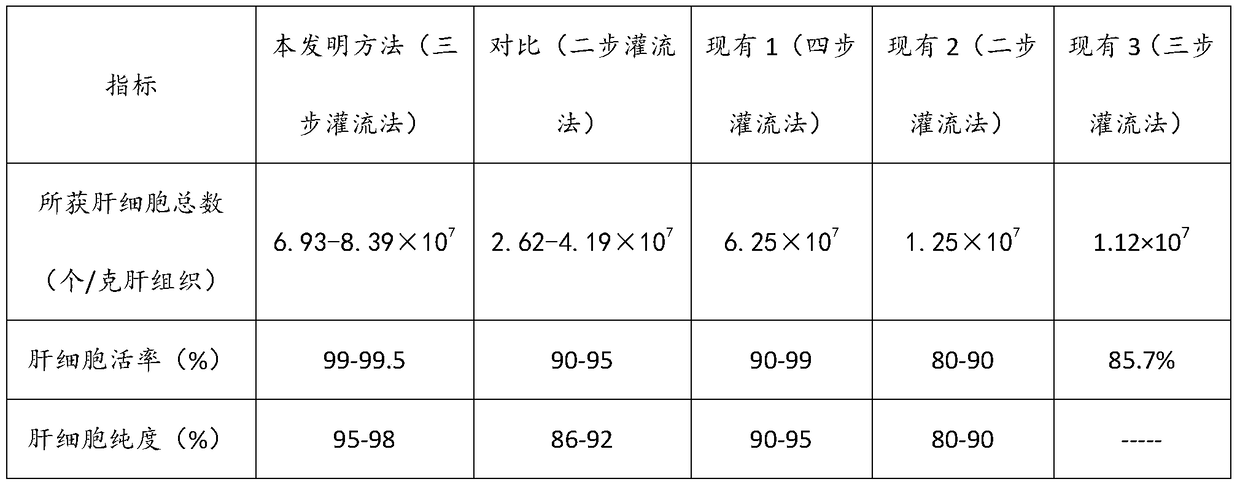Isolation and preparation method of primary hepatocytes
A technology of primary hepatocytes and hepatocytes, applied in the field of medical biology, can solve the problems of low purity, unsatisfactory total number and purity of hepatocytes, and many perfusion steps. The effect of high activity rate and purity
- Summary
- Abstract
- Description
- Claims
- Application Information
AI Technical Summary
Problems solved by technology
Method used
Image
Examples
Embodiment 1
[0050] Embodiment 1 Isolation and preparation method of primary hepatocytes of the present invention
[0051] 1. Test reagents
[0052] Perfusate I, perfusate II, perfusate III, liver cell washing solution;
[0053] The respective preparation methods are as follows:
[0054] 1. Perfusate Ⅰ: Take the preparation of 1 liter reagent as an example:
[0055] (1) Take the following ingredients: 8.3 grams of sodium chloride, 0.5 grams of potassium chloride, 2.4 grams of HEPES, 4 grams of NAC, and 0.95 grams of EGTA;
[0056] (2) Mix the above ingredients, dissolve in deionized water, stir at room temperature for 10 minutes to fully dissolve, adjust the volume to 1L, adjust the pH to 7.4, filter and sterilize with a 0.2 micron filter membrane, and store at room temperature. When in use, preheat to 37°C.
[0057] 2. Perfusate II: Take the preparation of 1 liter reagent as an example:
[0058] (1) Take the following ingredients: 8.3 grams of sodium chloride, 0.5 grams of potassium ...
Embodiment 2
[0078] Embodiment 2 Isolation and preparation method of primary hepatocytes of the present invention
[0079] 1. Test reagents
[0080] 1. Perfusate Ⅰ: Take the preparation of 1 liter reagent as an example:
[0081] (1) Take the following ingredients: 8.1 grams of sodium chloride, 0.5 grams of potassium chloride, 2.6 grams of HEPES, 4.5 grams of NAC, and 1.1 grams of EGTA;
[0082] (2) Mix the above ingredients, dissolve in deionized water, stir at room temperature for 10 minutes to fully dissolve, adjust the volume to 1L, adjust the pH to 7.4, filter and sterilize with a 0.2 micron filter membrane, and store at room temperature. When in use, preheat to 37°C.
[0083] 2. Perfusate II: Take the preparation of 1 liter reagent as an example:
[0084] (1) Take the following ingredients: 8.1 grams of sodium chloride, 0.5 grams of potassium chloride, and 2.6 grams of HEPES;
[0085] (2) Mix the above ingredients, dissolve in deionized water, stir at room temperature for 10 minut...
Embodiment 3
[0104] Example 3 Isolation and preparation method of primary hepatocytes of the present invention
[0105] 1. Test reagents
[0106] 1. Perfusate Ⅰ: Take the preparation of 1 liter reagent as an example:
[0107] (1) Take the following ingredients: 8.5 grams of sodium chloride, 0.5 grams of potassium chloride, 2.2 grams of HEPES, 3.5 grams of NAC, and 0.9 grams of EGTA;
[0108] (2) Mix the above ingredients, dissolve in deionized water, stir at room temperature for 10 minutes to fully dissolve, adjust the volume to 1L, adjust the pH to 7.4, filter and sterilize with a 0.2 micron filter membrane, and store at room temperature. When in use, preheat to 37°C.
[0109] 2. Perfusate II: Take the preparation of 1 liter reagent as an example:
[0110] (1) Take the following ingredients: 8.5 grams of sodium chloride, 0.5 grams of potassium chloride, and 2.2 grams of HEPES;
[0111] (2) Mix the above ingredients, dissolve in deionized water, stir at room temperature for 10 minutes ...
PUM
 Login to View More
Login to View More Abstract
Description
Claims
Application Information
 Login to View More
Login to View More - R&D
- Intellectual Property
- Life Sciences
- Materials
- Tech Scout
- Unparalleled Data Quality
- Higher Quality Content
- 60% Fewer Hallucinations
Browse by: Latest US Patents, China's latest patents, Technical Efficacy Thesaurus, Application Domain, Technology Topic, Popular Technical Reports.
© 2025 PatSnap. All rights reserved.Legal|Privacy policy|Modern Slavery Act Transparency Statement|Sitemap|About US| Contact US: help@patsnap.com

